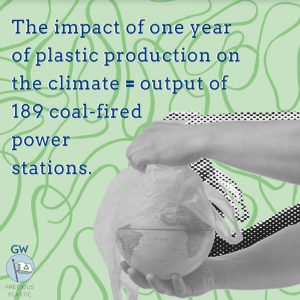In the minds of most, the plastic problem is most readily associated with pollution. Images of beaches covered in plastic bottles, sea turtles and fish swimming with plastic bags, and the sides of roads littered with colorful pieces of trash are the first things that come to mind. Plastic pollution is generally referred to as a separate issue from climate change, but, in fact, the production and disposal of plastics contribute significantly to climate change-inducing emissions. A 2019 report by the Center for International Environmental Law determined that the impact of plastic production on the world’s climate in one year will equate to the output of 189 coal-fired power stations, and according to a report by Yale’s Climate Connections, “today, about 4-8% of annual global oil consumption is associated with plastics… If this reliance on plastics persists, plastics will account for 20% of oil consumption by 2050.”
Plastic is made out of crude oil, which means it is one of the many cogs of the fossil fuel industry. From cradle to grave, plastics emit greenhouse gases in nearly every phase of their long lifecycle. The same processes used to extract oil for fuel are used to extract oil for plastic–fracking, drilling wells, and land disturbance. The emissions from driving a car is more likely to be linked with intensifying climate change than using plastic utensils or taking your carry-out in a plastic container, but both have their origins in extracted fossil fuels.
The disposal of plastic waste is equally destructive to the planet, and though recycling is a better alternative than using virgin plastic, large-scale recycling facilities are energy and resource-consuming. Even so, the greenhouse gas emissions saved from not having to extract new oil offset the small amount of greenhouse gasses produced from recycling. Making new products from recycled plastic is more than 3x more efficient in terms of greenhouse gas emissions than manufacturing those same products with virgin raw materials. Unfortunately, our plastic waste problem does not end here. The high costs of recycling paired with the low costs of obtaining virgin plastic mean that “plastic recycling is rarely profitable and requires considerable government subsidies.”
As recycling policies have changed worldwide, recycling has become an even more expensive form of waste management. Rather than investing in more or better recycling facilities, countries have increasingly turned to incineration. In only one year, in the United States alone, “The climate impact of plastic waste incineration… [was] equivalent to 1.26 million passenger vehicles driven for one year, or more than half a billion gallons of gasoline consumed.” Incineration isn’t only an injustice to the planet, it is also an extreme detriment to human health. For workers who spend their day in incineration facilities and for the communities living near these operations, the pollutants from burning plastic can seriously threaten one’s health. While landfilling plastic waste has fewer immediate greenhouse-gas associated costs, the placement of landfills presents similar injustices as incinerators do.
Let’s recall the image of oceans filled with plastic again. Plastic floating around in the water has become as normal to the scenery as seaweed or other aquatic life, but plastic pollution in the ocean has a much more deadly effect on the planet than can be immediately perceived. When rainforests are characterized as being the greatest carbon-eating entity, it is easy to forget that our oceans are the largest natural carbon sink for greenhouse gases. Plastic chokes this process in several ways. Not only does plastic in the ocean heated up by the sun release harmful greenhouse gasses such as methane and ethylene, but microplastics also hurt one of our ocean’s biggest unsung heroes–plankton. Plankton play a crucial role in “taking carbon dioxide from the atmosphere and water and sequestering it in deep ocean sinks.” This is already an issue when at least 8 million tons of plastic waste enters our oceans each year, but with this number set to double by 2030, the seemingly imperceivable disruption of ocean plankton will have severe costs to the climate.
No matter how plastics are disposed of, environmental degradation is inevitable. Curtailing our reliance on plastic is critical in fighting the impacts that plastic has on all scales of life–from tiny plankton in our seas, to our earth’s climate.



Be First to Comment